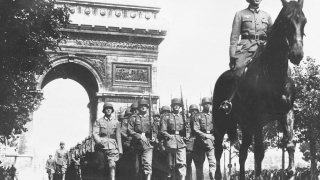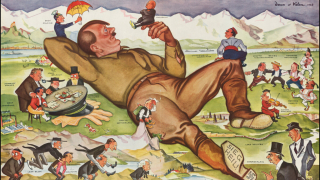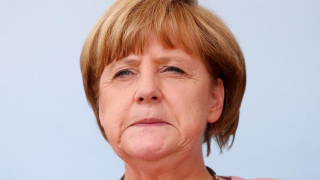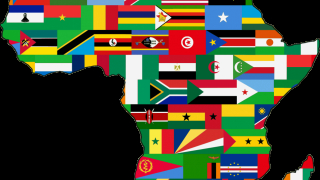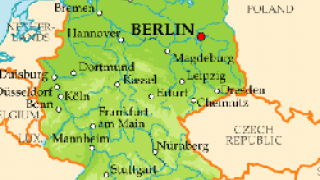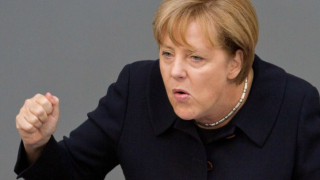The German Empire's policies in Europe and the Tsarist regime's fall
When in February 1918, the German politician Prince Max of Baden asked his country's military dictator, Erich Ludendorff, what would happen if the latter's spring offensive failed, he replied, “Then Germany will just have to suffer annihilation”.
General Ludendorff's response, which offended Prince Max's sensitive liberal tastes, would be repeated almost verbatim by Hitler a generation later, and it reveals the all-or-nothing nature of the Ludendorff autocracy. Yet the general knew that Germany's enemies, all imperialist states themselves (France, Britain and America), were never going to grant the Germans a reasonable peace, as was borne out in stark fashion at Versailles.
By the early winter of 1914, Ludendorff was already one of the most powerful men in Germany. As the months advanced, he would increasingly become the sole centre of real influence in the country, and also across the vast occupied territories where his dictatorship extended. Ludendorff's war aims consisted of establishing what would be a Greater Germania, the pre-eminent force on the European mainland, and in that scenario second only to the United States in global power terms. Britain, previously the earth's dominant nation, has been in decline since about 1871. She was overtaken that year as the world's largest economy by America, with the gap widening as time wore on. (1)
Come the turn of the 20th century, German industrial growth including steel and pig iron production had likewise surpassed Britain. The German Empire's industrial capacity was, by 1905, the second most advanced on earth, though still appreciably behind America. France was trailing badly – French regression can be traced to the Napoleonic Wars of the early 19th century (2), which bled France white, culminating in the 1815 exile of Napoleon Bonaparte.
French woes deepened in the early 1870s, when Prussia decisively defeated her in the Franco-Prussian War. France was thereby stripped of the provinces of Alsace and Lorraine, which the new German Empire annexed, the ultimate humiliation for France. The burning French desire, to recover Alsace-Lorraine, was a central factor in the eruption of hostilities in the late summer of 1914.
Field Marshal Paul von Hindenburg shared his partner General Ludendorff's expansionist dreams. The two men agreed firmly on the extension of Germany's frontiers as far as conceivably possible, with their gaze fixed mainly to the East. They intended to Germanise and colonise large areas of central and eastern Europe, such as Poland along with the Baltic countries of Lithuania and Latvia. On 19 December 1917, Hindenburg said that he wanted the Baltic regions for strategic purposes in the next war.
As the fighting continued from its opening months, Germany's eastern divisions were capturing significant chunks of territory from the Russians, who still fought well. By the end of September 1915, however, the Imperial Russian Army had lost almost two million men in less than 14 months of fighting. As the Germans marched further eastwards, in late October 1915 Ludendorff and Hindenburg, in order to be closer to the front, moved from their previous headquarters at Lötzen (north-eastern Poland) and relocated to Kovno (central Lithuania).
During breaks in the fighting, Ludendorff could occasionally be seen by the locals in Kovno walking around the town, in his military attire and Pickelhaube, the spiked helmet – while the few German armoured vehicles patrolling Kovno's streets would honk their horns at Ludendorff, as they drove past him, and he would wave back at them. Hindenburg was more likely to be spotted in the forests of Augustovo or Bialoviesa, hunting for game with his rifle, but he complained that “The wolves seemed to have a preference for slipping away beyond the range of my gun”.
Ludendorff in particular wanted to annex the ancient province of Courland – in western Latvia – a low-lying, fertile land, of great strategic relevance and resting on the Baltic Sea, with Scandinavia slightly further on. A German merchant service in the Baltic waters astride Courland was, as Ludendorff wrote, “of paramount importance to us, on account of the importation of iron ore from Sweden”. (3)
Courland had a history of Germanic rule dating to the 13th century, and was home to tens of thousands of Baltic Germans. It gave Ludendorff considerable satisfaction when, in the late summer of 1915, forces under his command captured Courland from the Russian Empire.
On 27 August 1916 Romania, a country of considerable importance, unexpectedly declared war on the Central Powers of Germany and Austria-Hungary, causing something close to panic in Berlin. Just the day before, Kaiser Wilhelm II had been assured by General Erich von Falkenhayn that Romania would stay neutral. Romania's declaration of war was a sure indication that neutral nations, whose interests were at stake, believed Germany was heading for defeat. Furthermore, Romania contained huge quantities of oil and wheat.
Two years into the war Romania's decision to join the Entente, of Russia, France and Britain, was also an act of betrayal, for Romania had signed a defensive alliance on 30 October 1883 with Germany and Austria-Hungary. This pact, which had been at Romania's behest because of her bitterness against Russia for taking Bessarabia, was renewed as late as 1913. Encouraged by Western diplomats, the Romanians wanted to take the famous province of Transylvania from Hungary.
On the night of 27 August 1916, around 750,000 Romanian troops began marching on Transylvania through the high Carpathian mountain passes. A paltry six German-led divisions initially opposed the Romanian Army, but within a week, due to efficient staff work and logistical operations, Ludendorff bolstered this force to 16 divisions. The Romanians soon proved no match for the Germans. By mid-November 1916, remnants of Romania's divisions were driven northwards into the hilly region of Moldavia, but they escaped outright destruction to fight another day. On 6 December 1916 the German Field Marshal, August von Mackensen, rode in triumph through the streets of Bucharest on his white horse.
The Romanian campaign raised morale in Germany, improved the country's standing in Europe; and most critically of all for Ludendorff and Hindenburg, allowed them to resume exploiting Romania's raw materials; without which the Germans could not continue the war.
By December 1917, the Ludendorff dictatorship was in control of all of central Europe and most of eastern Europe; while Belgium was long under German military occupation, and the Germans had a firm foothold in eastern France (4). Since the conflict's outset, Berlin had poured millions of marks into trying to foment revolution in Tsarist Russia, a nation which had been under Romanov dynasty rule for over 300 years. In October 1917, Vladimir Lenin's taking of power in Russia signalled the end of the Kremlin's involvement in World War One.
Soviet Russia concluded an armistice with the German Empire on 15 December 1917, and Ludendorff wrote how, “I felt as though a weight had been removed from my chest” (5). He could finally begin directing his military resources towards one principal front, a grand luxury which the Allies were much accustomed to.
For three years, Germany had survived fighting on two broad fronts against the might of Russia, France and Britain because, as the Canadian historian Lt. Col. Donald J. Goodspeed outlined, “All through the war, the Germans – and Ludendorff especially – placed a far higher premium on brains than did the Allies” (6). Moreover, Lt. Col. Goodspeed recognised “the excellence of the German Army, which was a very serious and professional organisation. It was not by any means the largest army on the continent, but it was by all odds the best”. (7)
The truth is often unpopular, and it should be acknowledged too that Ludendorff himself was quite clearly the most formidable commander of World War One. In the end, only the combined strength of the British, French and American armies would leave him checkmated. Ludendorff's offensive and defensive doctrines demonstrated more imagination and military talent in comparison to his rivals – such as the inflexible British commander Douglas Haig, perhaps unfairly nicknamed “Butcher Haig”. Yet he needlessly sent hundreds of thousands of British soldiers into death traps, where they were mowed down by German machine-gun and rifle fire.
By contrast Ludendorff had no issue in altering his tactics if required, or to recognise ability in others and to reward it. He had an eye for talent, and designated greater responsibilities to first class officers, like Max Hoffmann and Georg Bruchmüller. Unlike his British counterparts, Ludendorff regularly visited the front line to view conditions with his own eyes, and to interview officers involved in the fighting (8). Ludendorff's position was strengthened by having Hindenburg at his side throughout the war; Hindenburg's role may have been much less pronounced but, unlike Ludendorff, he was hardly ever ruffled and had nerves of steel. In difficult moments, he always calmed and reassured the more easily agitated Ludendorff.
In their colonial territories, British and French generals were long used to beating badly equipped and unprepared forces, often consisting of once peace-loving indigenous groups. The Allied command structure placed too much emphasis on rank and correct age, ignoring ability due to engrained military protocol and short-sightedness.
It was not until 3 March 1918, that the Bolsheviks were compelled to surrender to Germany in writing, through a peace treaty signed at Brest-Litovsk. Two weeks before on 18 February 1918, Ludendorff ordered a German invasion all along the Eastern front, so as to press home his point to Lenin.
The one commander of the First World War who had been threatening to match Ludendorff, came not from the West, but from the East. He was the 57-year-old Grand Duke Nicholas Nikolaevich, a popular and respected Russian general, six feet six inches tall, broad-shouldered, and who had devoted his life to the Tsar's Army (9). In August 1914 the Grand Duke was appointed to the Supreme Command of all Russian forces. In this position he proved to be “a ruthless, iron-willed opponent who had held his armies together admirably, and whose strategic ideas had often been daring and brilliant”. (10)
Tsar Nicholas II committed a grave blunder the following year by firing the Grand Duke, on 5 September 1915, and then compounded the error by appointing himself to the Supreme Command. When news of the Grand Duke's dismissal reached German Ober Ost headquarters at Lötzen, it was welcomed heartily by Ludendorff, Hindenburg and Hoffmann (11). With the Grand Duke's exit, the Russian Empire was not only stripped of its most able commander but, subsequently, every defeat suffered by Russia could be blamed on the Tsar. As would be the case. The Grand Duke's sacking was a factor in the Tsarist regime's fall 18 months later.
In the early 20th century, there were very significant numbers of Jewish citizens resident across central and eastern Europe (12) (13) – such as in Warsaw (Polish capital), Kovno (central Lithuania), Vilnius (Lithuanian capital) and Grodno (western Belarus); cities which all fell to the Germans in the early autumn of 1915. These cities' populaces comprised of 25% Jewish people or more, and were occupied by the Germans for three years. Ludendorff may have been anti-Semitic but, as opposed to the Nazis, he did not order the mass persecution or killings of Jewish or indeed Slavic people, which lays bare how much more extreme the Hitler dictatorship was.
Ludendorff and Hindenburg were concerned primarily with extracting the livestock and natural resources from the conquered territories. The German authors, Jens Thiel and Christian Westerhoff, observed how a main priority for Germany's warlords in the occupied regions, such as the Baltics, “was the exploitation of the extensive agricultural and forestry resources for the German war effort”. (14)
In September 1916, Ludendorff issued a compulsory labour law. For the remainder of the war every German male, aged between 15 and 60, was employed in the service of the state. He ensured that a sizeable percentage of women were sent to the munitions factories to work. The labour law eased Germany's manpower crisis, while female munitions workers performed a role in the increased output of ammunition and guns for the German war machine. Ludendorff was bringing home the concept of total war to Germany. In addition, the general implemented plans to raise the birth rate, he improved housing standards, reduced the rate of venereal diseases, encouraged rural resettlement, and counteracted the effective Allied propaganda.
On 13 September 1916 and again on 3 October, Ludendorff ordered the governor-generals of Warsaw and Belgium to institute forced labour, so as to further assist in alleviating manpower shortages. Germany's utilisation of, what was effectively slave labour, pre-dated Ludendorff's rise to supreme power by about a year; but he increased it as the conflict entered its latter stages.
The slave labourers consisted mostly of prisoners of war, along with Polish and Belgian “help workers”, including some thousands of Jewish males from those countries. In fact “Jews were over-represented in forced labour”, but the evidence is lacking whether this was because of prejudice, or due to high levels of unemployment among Jewish men at the time (15). Conditions were substandard in the labour camps, with severe illness and mortality rates. Other colonial powers like Britain, France and Belgium had long exploited slave labour on a larger scale than Germany, such as in their African colonies, while during the war Tsarist Russia inflicted slave labour upon civilians in occupied Galicia.
The punishing British naval embargo against Germany and its ally Austria-Hungary, was imposed from August 1914 until eight months after the war, when it was finally lifted in July 1919. This blockade was implemented with the intention to derail Germany's war economy, and to harm non-combatants. Directly due to the embargo's effects, hundreds of thousands of German civilians slowly starved to death, most of them women, children and the elderly (death toll figures range from 424,000 to 763,000). The British blockade also killed an estimated 467,000 civilians in the Austro-Hungarian Empire (16). Those suffering the least were the German and Austro-Hungarian troops, who were relatively well fed in the occupied zones.
On 19 December 1917 at a Crown Council conference in Kreuznach, western Germany, Ludendorff expounded at length on his final peace terms to the new Bolshevik Russia. The Russian Army was now finished as a proper fighting force, their troops returning home in droves. Listening to Ludendorff hammer out his demands against Russia were the Kaiser, Hindenburg, Foreign Secretary Richard von Kühlmann, and the 74-year-old Chancellor Georg von Hertling.
Ludendorff was implacably set on taking a massive chunk out of the former Russian Empire's western flank, which he was in the process of absorbing into the Reich. It included regions stretching from the Baltics a thousand miles southward to the Black Sea. The German military leadership coveted the oil, timber, mineral deposits and grain from these regions, which would guarantee that Germany could easily withstand a British blockade in a future conflict.
While Ludendorff was speaking, Foreign Secretary von Kühlmann interrupted him, protesting against the severity of his terms against Russia. Ludendorff had little time for the cultured von Kühlmann, brusquely rejecting his arguments for “a peaceful conciliation with Russia”. Von Kühlmann turned to the 70-year-old Hindenburg, who had fallen sound asleep in an armchair by the fire, as had Chancellor von Hertling. Von Kühlmann shook the Field Marshal awake but Hindenburg, slowly stirring himself, staunchly backed Ludendorff's views.
Less than a fortnight later on New Year's Day 1918, after being very reluctantly persuaded, Ludendorff's former deputy Max Hoffmann expressed his views to the Kaiser on “the Polish question”, i.e., the extent of Germany's imperialist policies regarding Poland. Hoffmann, a more moderate figure than Ludendorff, proposed a German-Polish border not that dissimilar to today's frontier. He could see no point in coercing millions of discontented Poles into the Fatherland, and the Kaiser agreed enthusiastically with Hoffmann's ideas. (17)
The following morning of 2 January 1918, at another Crown Council meeting – where Ludendorff, Hindenburg and Hoffmann were in attendance – the Kaiser strode gaily into the room, and outlined precisely on his map where the German border with Poland should fall, swiftly attributing the proposal to Hoffmann. Ludendorff could scarcely believe what he was hearing, and he then became very angry. His face turned pink, purple, his neck began to swell and the veins were enlarged on his forehead. Hoffmann was watching Ludendorff with quiet fascination.
Ludendorff vehemently protested against the Kaiser receiving advice through separate channels, declaring that it undermined all military discipline. He criticised Hoffmann's suggestions root and branch, and insisted that they be rejected immediately. Ludendorff said that he now wanted to make representations of his own, relating to German intentions via Poland, which were expansionist and the opposite to Hoffmann's views. Hindenburg then nodded his giant head approvingly to reinforce Ludendorff's position, and the Kaiser, completely taken aback, hastily reassessed things and accepted the warlords' demands. Ludendorff never forgave Hoffmann for going behind his back, and thereafter he would communicate with him only through his Chief of Operations Max Bauer.
Notes
1 Caleb Silver, “The top 20 Economies in the World”, Investopedia, 18 March 2020
2 Donald J. Goodspeed, The German Wars (Random House Value Publishing, 2nd edition, 3 Apr. 1985) p. 5
3 Erich Ludendorff, Ludendorff’s Own Story, August 1914-November 1918, The Great War (Pickle Partners Publishing, 12 Apr. 2012) Chapter 6, The Headquarters of the Commander-in-Chief on the Eastern front in Kovno
4 HistoryofWar.org, “First World War – Dec 1917 Russia Out”
5 Ludendorff, Ludendorff's Own Story, Chapter 1, the Entente Offensive in the first half of 1917
6 Donald J. Goodspeed, Ludendorff: Soldier: Dictator: Revolutionary (Hart-Davis; 1st edition, 1 Jan. 1966) p. 195
7 Goodspeed, The German Wars, p. 36
8 Goodspeed, Ludendorff, p. 184
9 Charles T. Evans, “Notes on Grand Duke Nikolai Nikolaevich (1856-1929)”, Northern Virginia Community College, 5 July 2012
10 Goodspeed, Ludendorff, p. 136
11 Ibid.
12 Jewish Population Density – in Europe about 1900
13 JewishGen.org, “World Jewish Population”
14 Jens Thiel, Christian Westerhoff, “Forced Labour”, International Encyclopedia of the First World War, 8 October 2014
16 Alexander B. Downes, Targeting Civilians in War (Cornell University Press, 20 Mar. 2008) p. 87
17 Goodspeed, Ludendorff, p. 188



